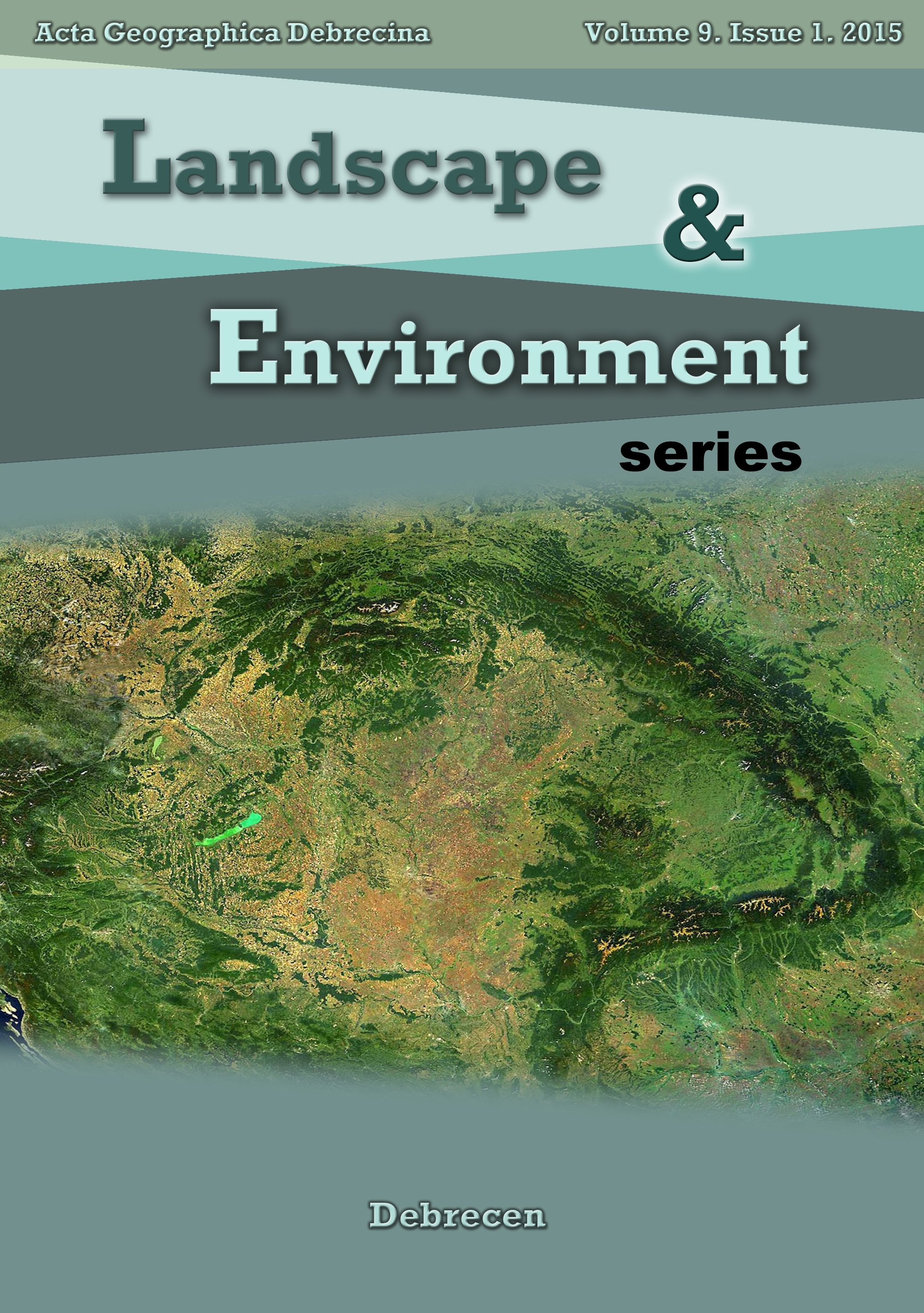Vol. 9 No. 1 (2015)
Bakó G. - Kovács G. - Molnár Zs. - Kirisics J.- Góber E. - András Ambrusd A. The developement of red mud flood environmental information system and the methodology for the spatial analysis of the degraded area
Németh R. - Dobos E. Flood model for the Bódva catchment
Boromisza Zs. - Ács T. - Pádárné Török É. Integrating applied lake ecology into spatial planning: towards a socially acceptable lakeshore restoration at Lake Velence (Hungary)
Botos Á. - Örkrös V. - Tóth Cs. Soil aggregate stablity, organic carbon and plant available nutrient contents (N,P) in soils of prehistoric mounds after abandonment of cultivation
##issue.tableOfContents##
Articles
-
The developement of red mud flood environmental information system and the methodology for the spatial analysis of the degraded area
1-11Views:321The red mud disaster occurred on 4th October 2010 in Hungary has raised the necessity of rapid intervention and drew attention to the long-term monitoring of such threat. Both the condition assessment and the change monitoring indispensably required the prompt and detailed spatial survey of the impact area. It was conducted by several research groups - independently - with different recent surveying methods. The high spatial resolution multispectral aerial photogrammetry is the spatially detailed (high resolution) and accurate type of remote sensing. The hyperspectral remote sensing provides more information about material quality of pollutants, with less spatial details and lower spatial accuracy, while LIDAR ensures the three-dimensional shape and terrain models. The article focuses on the high spatial resolution, multispectral electrooptical method and the evaluation methodology of the deriving high spatial resolution ortho image map, presenting the derived environmental information database.
pdf66 -
Flood model for the Bódva catchment
12-26Views:228In term of floods the current area of Hungary has extensively been endangered. Modelling of flood processes – mainly following the hydrological events in the riverbed – has recently been developed. As far as protection dykes provide protection of the inhabited and agricultural areas, the flood models can run with acceptable preciseness. However, when dykes cannot withstand against the increasing load and a dyke burst occurs, fast and efficient protection measures shall be taken in the protected areas. The dynamic 4D Flood model presented in this paper makes possible a fast modelling of dyke burst occurring in the protected side and spreading of water mass, based on real parameters. For this reason the features of protected area shall be recognised, for example topology of creeks, features of agricultural and inhabited areas, parameters of roads, railways, rainwater drainage, buildings, natural conditions (soil parameters, meteorological characteristics, etc.). The results satisfy the comprehensive demands of the Directorate General for Disaster Prevention of Borsod-Abaúj-Zemplén County. In case of dyke burst, the completed Flood Model can run the expected events of the next hour in a few minutes. This time is enough for the specialists to bring operative decisions to protect the inhabitants and avoid material losses.
pdf121 -
Integrating applied lake ecology into spatial planning: towards a socially acceptable lakeshore restoration at Lake Velence (Hungary)
27-41Views:325A good chance of a socially accepted shore-restoration that is sustainable for the long run stands only, if all those, concerned in lake use, are also interested in the ecological interventions, if shore-restoration serves social and economic purposes, as well. In the previous phase of our research, assessments were made to find the sections of the shore zone that are suitable for restoration: to detect the sites where the existing artificial shoreline stabilization works could be removed. So that social demands should be involved in the assessment process, to begin with, structured interviews were made. According to the results, the share of the plots, being suitable or partially suitable for shore-restoration, slightly exceeded 7%. The analysis of restoration’s limiting factors has shown that the type of shoreline stabilization, the width of zone covered by emergent macrophytes, the extent of human pressures, and the relevant regulations on zoning (fixed in urban plans) together set limits to restoration. The interviews have made it clear that as a result of the changed demands on recreation-tourism, also the natural and landscape values have become more significant.
pdf156 -
Soil aggregate stablity, organic carbon and plant available nutrient contents (N,P) in soils of prehistoric mounds after abandonment of cultivation
42-50Views:232Prehistoric mounds are valuable archeological and nature conservational sites of the Hungarian lowland. However, due to the machinery cultivation most of them were plowed during the 20th century. After setting new legislative frames of their preservation, former cultivated mounds were abandoned and spontaneous regeneration processes of vegetation and soil could initiate on the ex lege mounds. Four mounds situated within the National Park of Hortobágy were investigated after their cultivation were abandoned, regarding their most important soil properties such as aggregate stability, bulk density, nitrogenous and phosphorous content, pH, organic carbon content and secondary carbonates.
pdf70
